In May we’re releasing Imperium: Classics and Imperium: Legends, two standalone deck-building civilisation games designed by Nigel Buckle and Dávid Turczi.
Today on the Blog, Nigel is giving an in-depth look at the solo mode included in both games, and the design behind it.
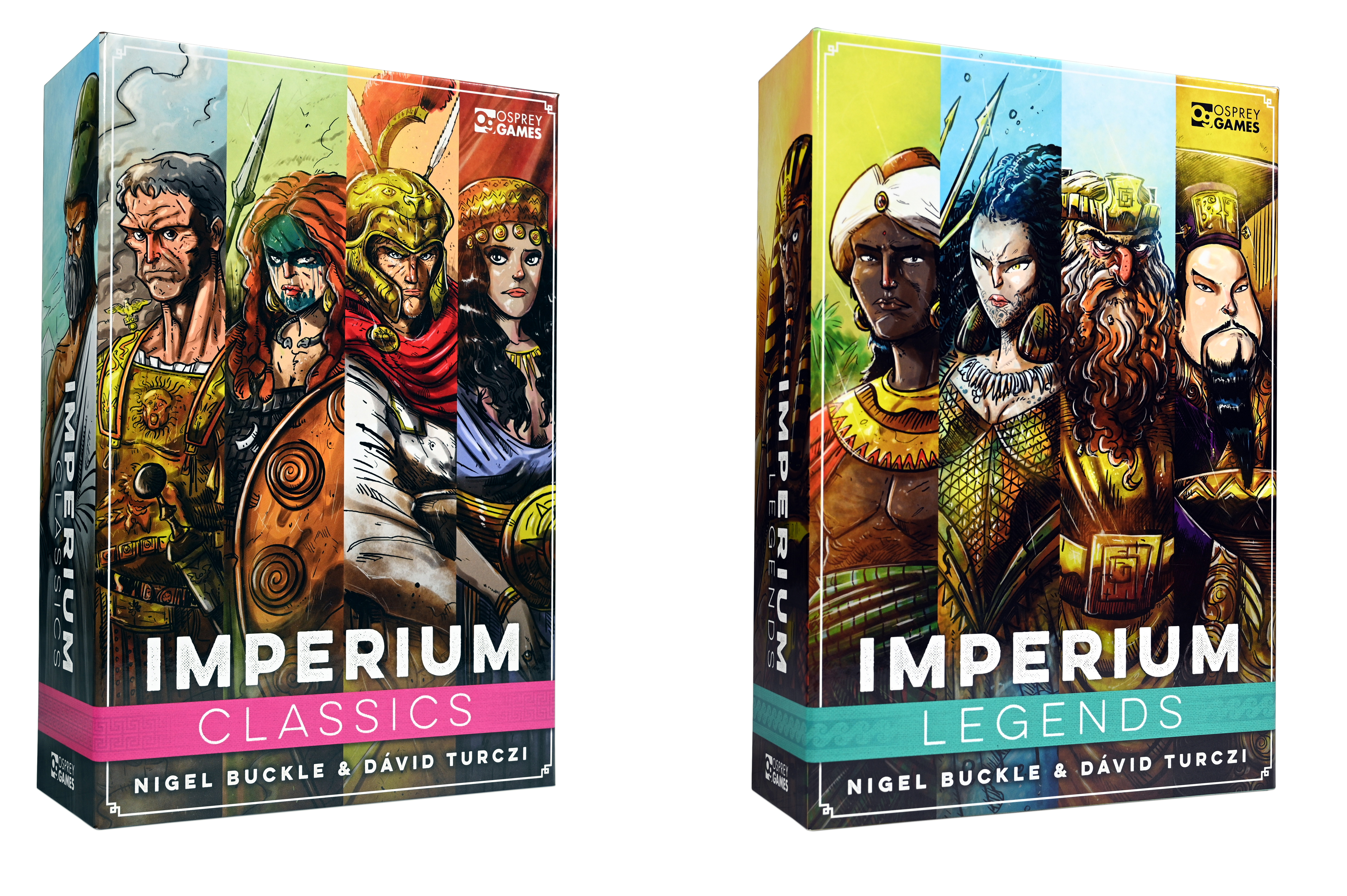
Imperium did not spring as a complete game from my brain. It has developed slowly through repeated plays and feedback from my long-suffering play testers, along with significant input from my co-designer David, and the other developers involved with the project.
I decided very early on that I needed a solo opponent (called a BOT) so I could create and test the asymmetric nation decks. What seems fine on paper often turns out far from that when you actually start playing and I really did not want to ask people to try the game when things were clearly not working.
So, the initial solo mode was really a test mode, rather than a fulfilling and complete solo experience. However, given how many times I anticipated using it, I wanted it to be neither a chore to run nor utterly soul-destroying. My original test mode has a few similarities to the solo mode we’re providing in Imperium, but there are many things it lacked compared with the final polished version.
When David joined the project, the issue of a solo mode was soon discussed. It did not take long to realise my trusty old test mode was not going to cut it. David has a philosophy when it comes to solo modes, or more accurately a formula led approach to designing a solo AI, which ensures a more rewarding experience than simply ‘beat your last score’. David’s approach is always concerned with interaction and strategic reasoning. What can my opponent do that can affect me? What can I do to affect my opponent? Or, in the case of a wildly asymmetric game like Imperium, how does my experience change with the civilisation my opponent plays?
We sat down and went through a number of questions. Then, independently, we ranked the answers as to how important each of us felt they were in the game. This then gave the objectives for the solo mode and the order of priority.
In general, we looked at:
1. What ways do you directly care about what your opponent is doing?
- Taking cards that you wanted from the market, adding resources to the market (affecting your and your opponent’s desire to take a particular card), and exiling cards from the market.
- How they directly interfere with your game, giving you unrest, stealing your resources, disrupting your tableau, or causing you to draw or discard cards.
- Taking Fame cards - both as an annoyance and as a reliable way to push the game’s clock.
- Accelerating the game – either rushing the Fame deck or pushing the market to exhaust or rapidly developing their cards to trigger an end game that way.
- Linked to accelerating the game, how far off is your opponent from becoming an empire, as this might affect your counter-play.
- How many progress tokens has your opponent collected and how many variable victory point cards have they taken? To serve as a measure of their success to compare yourself against.
2. What signals do you get in the game to indicate what your opponent might be doing and does it in any way affect your play?
- Most of the list above; if you’ve seen a player add a card to their deck you know it’s likely to be played and certainly each civilisation has some more obvious strategies that a player is likely to adopt. For example, you can expect the Roman player to hit the Fame deck or the Celt player to start handing out unrest like gifts at a birthday party...
- How quickly does your opponent cycle their deck and when are they going to become an empire?
- What types of card is your opponent collecting? Can you see a strategy emerging and what can you do to disrupt it?
While answering these questions we also considered that solo mode cannot be just ‘flip a card and do it.’ The solo experience needed to reward clever play and give you some of the feeling you are playing against a person, while at the same time being straightforward and quick to manage.
We also agreed that the BOT needed to start as a Barbarian (with one exception, Atlantis) and then at some point become an empire, and then change its behaviour, just like a human player would when they switch from Barbarian to Empire state.
So, with all that in mind, aware of my desire to use the civilisation decks for the solo mode, David came up with a framework for the RomeBOT. We picked on Rome as the first BOT to design because it is one of the easier civilisations to play and it does a little bit of everything.
The framework appears simple, but it took a few iterations to get it right. You stack the BOT deck so it uses the starting deck the player would use, and adds nation cards added randomly after each deck cycle, like a player does. Then when the ascension card is drawn the BOT becomes an empire, and tstarts taking development cards, again, like a player does.
The BOT also has a hand of 5 cards, like a player does, but this is where it deviates. Instead of holding a hand of 5 cards and playing 3, the BOT has 5 cards laid out in a row face down to be resolved in order, and acquired cards go to the top of the BOT’s draw deck so you know they are coming out next turn. To introduce randomness, you roll a regular die and the number shown is the card you do not resolve on the BOT’s turn, you resolve the other 4, using a simple table very reminiscent of my original training BOT. Additionally, the rolled number is also the location where you add progress to the market at the end of the turn. This final step is a compromise of speed and simplicity.
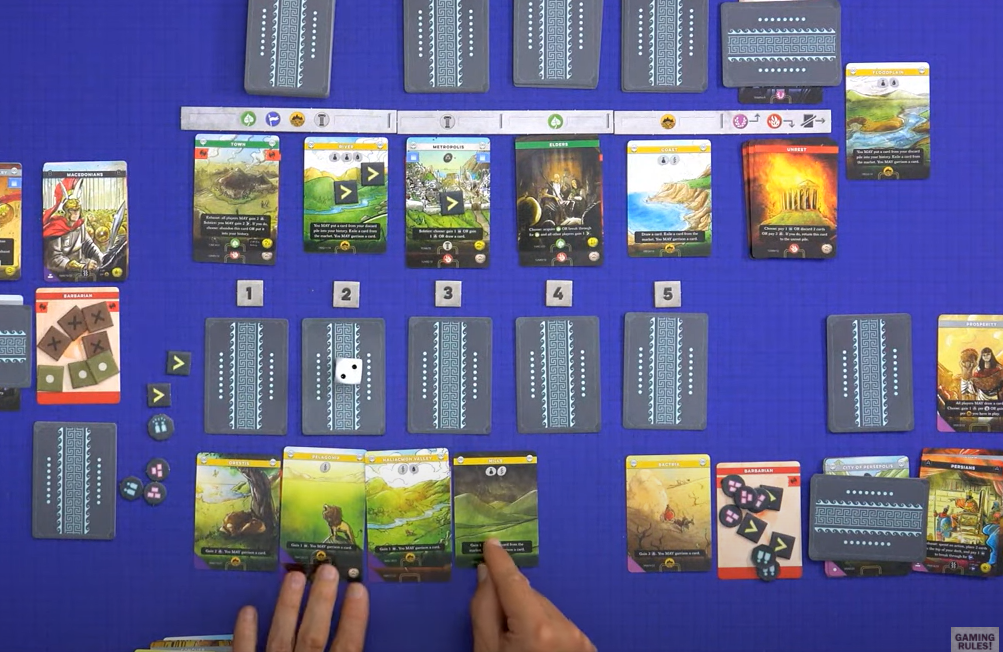
Photo from Gaming Rules! solo playthrough of Imperium. Link here.
When you resolve the card, you do not look at the card text. It was obvious that it would take players too long to resolve BOT turns if players had to do that. Instead, you have a chart that lists the possible icons, and you apply the effect corresponding to the first relevant icon. Furthermore, the BOT has two charts, one as a Barbarian and another when it becomes an Empire. Here is the one for Rome:
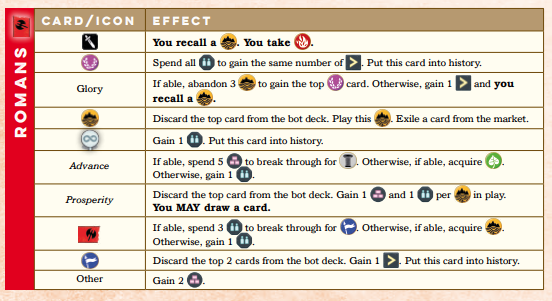
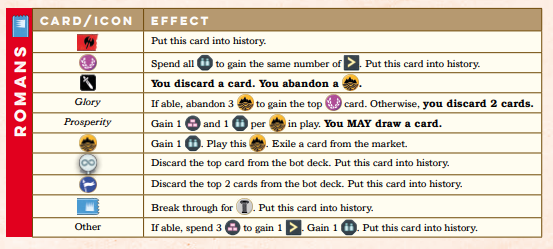
You can see the behaviour alters subtly between the two tables. The BOT deck was analysed along with the common cards and then the behaviour mapped out. Notice even the Glory entry is different. As a Barbarian the RomeBOT will abandon 3 regions and take Fame if it can. Otherwise, it takes a progress, and you have to recall a region. However, as an Empire again it will abandon 3 regions and take Fame if it can, but if it cannot then it has a much stronger attack - you have to discard 2 cards. This change reflects the likely attacks a Roman player would be throwing at you when a Barbarian or when an Empire.
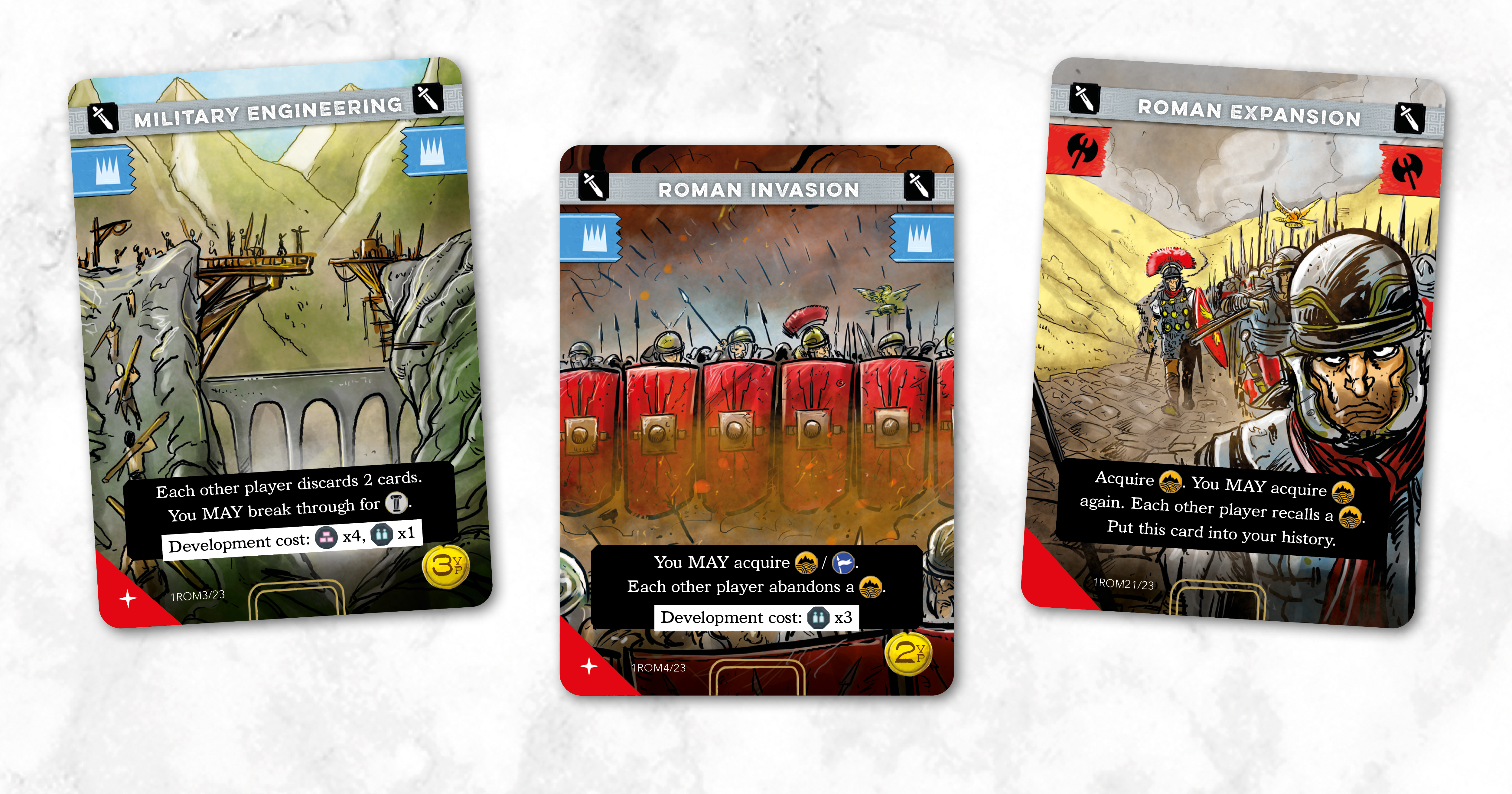
Coming up with the RomeBOT was a combined effort for the two of us, and we then played against it to ensure the framework held up. We quickly identified that the variable victory point cards were a problem, which is why the BOT values all “?” cards as their highest possible value and all “*” cards as a flat 5 Victory Points.
We also identified that the BOT simply gaining resources (materials and population) did not make much sense, so instead certain effects require the bot spend resources to take valuable victory point generating actions. As a Barbarian state, for example, the RomeBOT spends materials to break through for civilised cards, and spends population to break through for tributaries. When an Empire, this changes, and the resources are converted straight to progress when the appropriate icon is resolved. This gave the BOT a definite personality that you can begin to predict as you play against it.
I then repeated this same process for the other 7 BOTS in Imperium Classics. We then handed the BOTS over to solo gamers for them to try out and give feedback on. Based on these plays, we adjusted the charts to avoid some BOTS getting stuck in loops, added difficulty tweaks, and then extended our work to Legends. While the playtesters enjoyed the game, some felt they needed some additional motivation to keep playing beyond experiencing the different civilisations, so I linked the difficulty settings we had devised together and created a campaign mode. In the campaign mode. you play against 5 nations in turn, adjusting the difficulty up a notch each time. You also slightly alter your deck after each game to add weight to the decision of which cards to acquire during each playthrough.
However, playtesters are a tricky bunch and people hit on the strategy of flooding the BOT with unrest. You can try doing that to a human and they react by building a deck that can remove it efficiently. The BOT can’t adapt in that manner, so instead we introduced the rule that if the game ends in collapse (which is when the common unrest deck runs out) then the BOT wins, regardless who has more unrest. Now you can push unrest at the BOT, but if you do it too much the game can end suddenly and disastrously. This change also allowed me to introduce the Supreme Ruler mode to challenge even the best solo players. With this mode, you keep removing unrest from the common deck as you play each game, meaning later games in your campaign are more prone to collapse.
I hope solo gamers enjoy Imperium, and I encourage gamers to use the solo mode as a tutorial too. If you are struggling with a deck try playing it solo, or even play against the deck and watch the strategy the BOT takes, as it will be mirroring a viable strategy a human could use.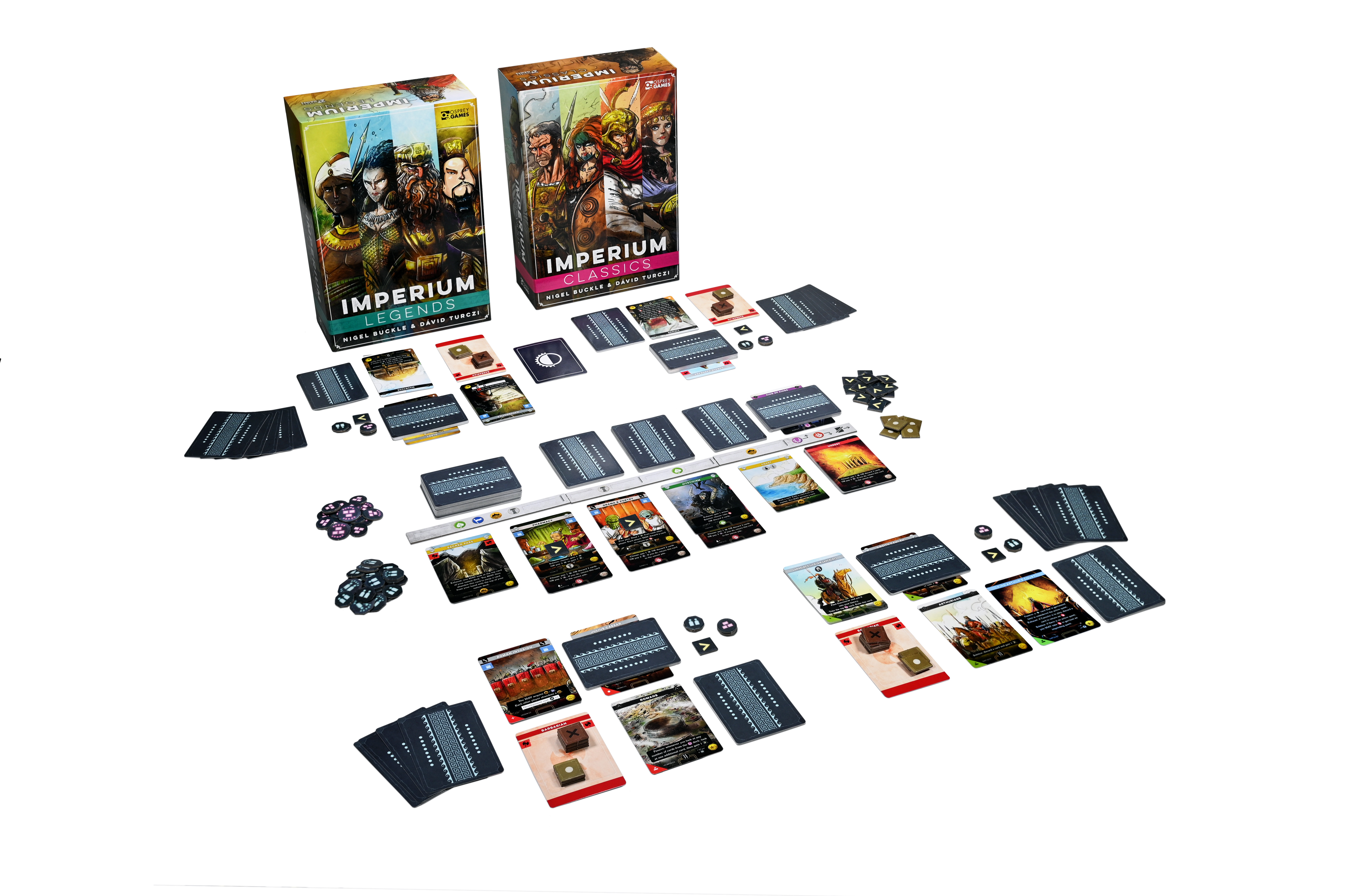
Imperium: Classics and Imperium: Legends are coming out in May 2021. Each box gives you 8 civilisations to lead to glory, and can be combined with one another for a total of 16 civilisations. Preorder your copies today!

Comments
You must be logged in to comment on this post. Click here to log in.
Submit your comment